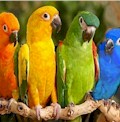One of the unique aspects of having a bird for a pet is that this is one of the few pets that may actually be trained to talk. Many people feel that they'll be able to communicate and have conversations with their pet birds but this may not be true in all cases. Even if a bird can talk fluently you must remember that even the smartest birds only have the intelligence of a toddler and therefore may not be able to tell you how they are feeling.
Whether your bird can talk or not, understanding what your pet is feeling is important to both you and your bird. One way to be able to do this is to be able to interpret his body language as this is a sure giveaway to his state of mind.
One good reason for understanding the body language of birds is that you can often avoid being bitten whether by your own pet or another exotic bird if you know when he is scared and when you should back off. If a bird is very scared, he will often try to make himself as thin as possible you will notice him standing very tall and looking very thin. His eyes may be dilated but they are not moving back and forth at all. In a way the bird is trying to make himself invisible - he thinks that if he makes himself as thin as possible and doesn't move that the creature that is scaring him will overlook him.
If you try to reach into the cage to do pet or pick up a bird that is acting like this he may lash out with you in terror and you may get a nasty peck. The best thing to do is to squat down so that the bird is higher than you and look right at them with your eyes closed. Speak to him in a soft soothing tone and slowly open your eyes. This should help to relax the bird as they feel most comfortable when they higher than anyone else. The closing of your eyes is important because they consider blinking a sign of trust. Once you've got your pet bird into this state it doesn't mean that he's a can automatically let you reach in and pick them up you still want to use caution until you have him fully tamed.
If you bird is angry you will notice that his head is weaving back and forth and his eyes are dilated. He may be squawking loudly and leaning slightly forward for easy attack. His feathers will be puffed up. you might want to try distracting him with a millet sprayers favorite treat but you probably will want to get too close or you may experience a painful bite. When your bird is angry like this it's best to let him come down before you try to approach him. Perhaps you might want to find out what made him angry so you can avoid this next time.
An excited bird might look similar to an angry bird with dilated pupils and he'll be bobbing (not weaving) his head and have ruffled feathers. Depending on how excited he has his whole body to be moving around. He might be squawking and screeching sometimes loudly. An excited bird, even though he is happy, may also bite you because he's too excited. It's best to let him come down a little bit before handling.
A calm content bird will be sitting on his perch with one leg tucked up under him. He'll be easy recognize due to his relaxed posture and he might groom oneself stretch out and even go to sleep. If you don't make any sudden moves that startled her you can probably get them pop up when you finger and let you pet him easily when he is in a state of mind.
Knowing how your bird feels is important for training and ongoing companionship. Once your bird is very tame you probably won't have to worry too much as he'll welcome your attention, but in the beginning knowing whether he is frightened, angry or excited can help you gain his trust for easier training.
